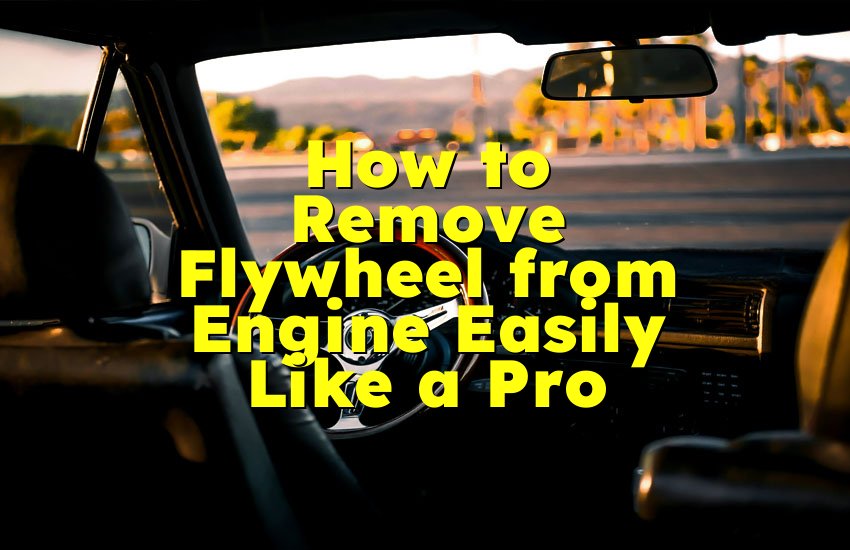As an Amazon Associate, I earn from qualifying purchases at no extra cost to you.
How to Remove Flywheel Without Puller Like a Pro
One evening, my friend Sam called me in a panic because his old dirt bike wouldn't start. He figured the flywheel was jammed but didn't have a puller. I remember thinking, "There's got to be a simple way." Turns out, there is. You just need the right approach, patience, and a few clever tricks. Let's walk through it together, step by step.
Start by disconnecting the battery and removing the engine cover carefully to reach the flywheel. Next, loosen the flywheel nut while keeping the crankshaft still. Then, use the hammer-tap method with a wooden block to break the flywheel free. If it's still stuck, apply heat around the flywheel center, then gently tap again. Once loosened, lift it out evenly without bending it. Finally, clean and inspect the crankshaft taper before reassembly.
Preparing the Engine and Work Area
Before jumping into removing the flywheel, it's smart to get your work area organized. A clean workspace means fewer chances of losing bolts or dropping washers. Lay out a towel or magnetic tray for parts. When Sam was working on his dirt bike, he didn't do this at first and spent half an hour looking for a tiny washer. So yes, preparation really saves time later.
Next, make sure the battery is disconnected. You don't want a surprise spark while working near metal tools. Then, remove the engine cover using the right-sized socket. Avoid forcing any bolts; if they're stuck, a bit of WD-40 can help loosen them. A rushed twist can easily strip threads, and that's something you don't want to deal with mid-project.
After removing the cover, inspect the flywheel area. Sometimes, grime or old oil builds up, making it slippery or harder to grip. A quick wipe with a clean rag can help you see what you're doing better. Always keep your tools nearby—having to search mid-process just slows everything down.
Finally, make sure the engine is stable. Whether it's on a bike stand or a solid surface, movement can cause slips or misalignment. One small wobble while you're tapping or heating the flywheel can ruin threads or crack components. Stability is key here.
Quick summary:
- Clean workspace and organize tools
- Disconnect battery for safety
- Remove engine cover carefully
- Keep engine stable on a solid surface
Loosening the Flywheel Nut
Now, you're ready to take on the flywheel nut, which often feels welded in place. The trick is holding the crankshaft still while you loosen it. A simple way is to wedge a soft piece of wood between the flywheel teeth and the casing. It keeps things still without causing damage. I've done this trick on small engines, and it works surprisingly well.
Grab the correct socket and turn it counterclockwise. If the nut doesn't budge, try a breaker bar instead of a regular wrench. It gives better leverage without forcing a quick jerk. A common mistake is hammering the wrench, which can harm internal parts. Patience and steady pressure do a much better job.
Sometimes the nut may have thread locker on it. In that case, a heat gun can make the job easier. Gently heating the nut helps soften the thread locker, making it easier to loosen. Just don't overheat the surrounding parts; a quick 10–15 seconds of heat is often enough.
Once the nut is off, keep it safely aside. You'll need it again for reinstallation. Many people forget and misplace small parts like this. It's worth dropping it into a labeled container or magnetic tray so nothing disappears during the process.
Quick summary:
- Hold crankshaft with soft wood piece
- Use breaker bar for better leverage
- Apply light heat if thread locker used
- Store nut safely after removal
Releasing the Flywheel from the Shaft
This is the part that feels tricky without a puller, but it's actually simple with the right technique. The flywheel is seated on a tapered shaft, which creates a tight fit. Over time, it can almost fuse with the crankshaft. The goal is to break that seal gently without damaging threads or the crank.
Start by threading the nut back onto the crankshaft loosely—just enough to protect the threads. Then, take a wooden block and place it over the flywheel's center. Tap the block gently with a hammer. The vibration helps loosen the taper fit. You'll feel it pop free after a few taps if you're doing it right.
If it's really stubborn, add a bit of penetrating oil around the shaft center and wait a few minutes. This small pause often saves a lot of effort later. Many people make the mistake of hitting too hard out of frustration, which risks cracking the flywheel. Always aim for gentle, repeated taps instead.
After it loosens, lift the flywheel evenly using both hands. Avoid prying one side too much, as this could bend or warp the flywheel. Once off, take a moment to admire your work—it's a satisfying feeling when that flywheel finally comes free.
Quick summary:
- Loosen nut but leave it on threads
- Tap wooden block with hammer gently
- Use penetrating oil for stubborn fit
- Lift flywheel evenly with both hands
Using Heat to Loosen a Stuck Flywheel
Sometimes, even after tapping and oiling, that flywheel refuses to move. Heat becomes your best friend in these moments. A little warmth can expand the metal just enough to break the seal. But here's the trick: you need to heat the flywheel center, not the crankshaft. That's where most people go wrong.
Use a small heat gun or propane torch set on low. Move it slowly around the hub area for 30–40 seconds. Avoid overheating—it shouldn't glow red. You're just trying to expand it slightly. Once heated, give the wooden-block tapping method another try. The sudden change in temperature and light vibration usually frees it right up.
When I helped my cousin with his lawnmower engine, we used this method after an hour of frustration. Within two minutes, the flywheel finally loosened. It's honestly satisfying when patience pays off like that. Just remember to wear gloves—metal heats quickly and stays hot longer than you think.
If it still doesn't come loose, apply a bit more penetrating oil once it cools slightly, then repeat the heating process. Alternating between heat and oil often works wonders. Just stay calm and methodical, and you'll get there.
Quick summary:
- Heat flywheel center evenly
- Avoid overheating crankshaft
- Combine heat and tapping technique
- Alternate with oil if still stuck
Cleaning and Inspecting After Removal
Once the flywheel is off, don't rush to reassemble things right away. This is the best time to clean and inspect everything. Check the crankshaft taper for dirt, rust, or small metal flakes. A clean fit ensures proper grip when reinstalling. Use a soft cloth and a bit of fine sandpaper to remove any debris gently.
Next, inspect the flywheel keyway slot. This small part keeps your engine's timing accurate. If it's damaged or worn, replace it before reinstalling the flywheel. Skipping this check can lead to poor engine performance or even backfiring later on. It's a small detail that makes a big difference.
Also, check the magnet areas on the flywheel for cracks or chips. Over time, rough removal or overheating can weaken them. A simple visual check helps you avoid trouble down the road. If you spot damage, it's worth replacing the flywheel instead of risking a future breakdown.
Finally, clean around the stator area before reassembly. Dust, oil, and old debris can affect electrical performance. Once everything is spotless and checked, you're ready to put things back together with confidence.
Quick summary:
- Clean crankshaft and flywheel taper
- Inspect keyway for wear or damage
- Check magnets for cracks
- Clean stator area thoroughly
Reinstalling the Flywheel Securely
Reinstallation is where many people rush, but it's just as important as removal. Place the flywheel gently on the crankshaft, aligning the keyway properly. It should slide in smoothly without forcing it. If it doesn't, double-check the key alignment—it's often slightly off by a millimeter or two.
Once seated, thread the nut back on by hand before tightening. This ensures it's not cross-threaded. Then, hold the crankshaft still using the same wood-wedge method and tighten the nut snugly. Avoid over-tightening—it can strip threads or crack the hub. A torque wrench helps if you have one, ensuring perfect tension.
After tightening, spin the flywheel lightly by hand to ensure it moves freely without wobble. Any uneven motion could mean it's not seated right. Take a moment to adjust if needed. It's better to spend an extra minute now than face vibration issues later.
Finally, reattach the engine cover and reconnect the battery. Once everything's back in place, give the engine a start test. That smooth spin-up sound means your work paid off.
Quick summary:
- Align keyway properly during reinstallation
- Hand-thread nut first to avoid cross-threading
- Tighten securely but not excessively
- Spin and test for smooth movement
Final Thoughts
Removing a flywheel without a puller might sound tough, but with patience and a few clever tricks, it's completely doable. The key is steady hands, the right tools, and a calm approach. Whether it's your dirt bike, mower, or generator, these steps can save you both time and money.
| Action | Tool Needed | Helpful Tip |
|---|---|---|
| Disconnect battery | Wrench | Always start with safety first |
| Remove engine cover | Socket set | Keep bolts organized |
| Hold crankshaft | Soft wood block | Prevents internal damage |
| Loosen flywheel nut | Breaker bar | Apply steady pressure |
| Tap to release flywheel | Hammer + wood block | Use gentle, even taps |
| Apply heat if stuck | Heat gun | Warm around center only |
| Clean crankshaft area | Cloth, sandpaper | Remove oil and rust |
| Reinstall flywheel | Torque wrench | Tighten securely, not overly |
Frequently Asked Questions (FAQs)
Is it safe to remove a flywheel without a puller?
Yes, it's safe if done carefully. The key is using soft tools like a wooden block to protect parts from impact damage. Many people damage crank threads by hitting metal-on-metal, so always cushion it. Working slowly, with even pressure and patience, makes the process safe. Remember, safety glasses and gloves are a must whenever you're tapping or heating metal parts.
Can I use a hammer directly on the flywheel?
It's strongly advised not to. Direct hammer blows can crack the flywheel or damage the magnets underneath. Always use a wooden block or rubber mallet as a buffer. That spreads the force evenly and protects sensitive parts. Even though it takes a few extra minutes, this simple precaution saves you from costly replacements later.
Do I need to heat the crankshaft too?
No, only heat the flywheel hub area. The goal is to expand the flywheel slightly so it breaks the seal with the crankshaft. Heating the crankshaft can damage seals or bearings nearby. Keep the heat moving around the flywheel center and don't let it stay in one spot for too long.
Is penetrating oil really necessary?
It can make a big difference, especially for older engines where the flywheel's been in place for years. The oil seeps into microscopic gaps and loosens corrosion buildup. Apply it, wait a few minutes, then start tapping gently. It reduces friction and helps the flywheel pop off much easier.
Can I remove the flywheel with the engine still mounted?
Yes, you can. Just make sure the engine is stable and won't move while you're applying force. If it's a small engine, a sturdy stand or even a wooden crate works fine. For larger ones, having a second person hold it steady helps. Stability makes all the difference in keeping things safe.
Do I need to replace the flywheel key every time?
Not always, but it's smart to check. If the key looks worn, bent, or damaged, replace it before reinstalling. It's an inexpensive part that controls engine timing, and skipping it can cause misfiring or hard starts later. Keeping a few spare keys on hand is always a good idea.
Can I use WD-40 instead of penetrating oil?
Yes, WD-40 can work in a pinch. It helps loosen grime and corrosion, though dedicated penetrating oils are usually more effective. If using WD-40, spray it lightly around the shaft and give it time to soak in before tapping. Don't rush—patience often gives the best results.
Do I need a torque wrench for reinstalling?
Using a torque wrench is best because it ensures you tighten the flywheel nut evenly and to the right specification. Over-tightening can damage threads, while under-tightening may cause wobble or slippage. If you don't have one, use firm, even pressure with a standard wrench, but never force it too hard.











